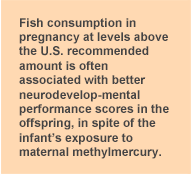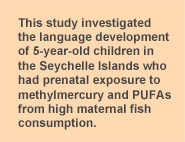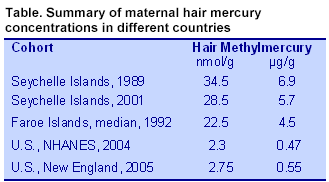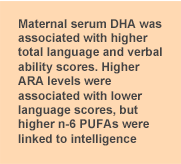
The importance of long-chain PUFAs, especially arachidonic and docosahexaenoic acids, in fetal and infant development is now well recognized, yet the consumption of fish and seafoods, the primary food source of the omega-3 long-chain PUFAs (n-3 LC-PUFAs), is clouded by concerns about the developmental effects of contaminants. All fish contain some mercury in the form of methylmercury, a known neurotoxin. Yet fish consumption in pregnancy at levels above the U.S. recommended amount is most often associated with
better performance scores on tests of cognition and behavior in the offspring, even as long as
17 years after birth. These findings have been observed in many countries, including the
U.S. where fish consumption is generally low. The presence of methylmercury and other contaminants can be confounding factors, but failure to
consider both beneficial and harmful substances in fish leads to misleading data interpretations. The Seychelles Child Development Nutrition Study is a longitudinal, prospective cohort study monitoring the development of the offspring of mothers with high fish consumption. The most recent findings from this study reported either improved performance or no association with prenatal methylmercury exposure in 26 of the 27 outcomes measured. The study has repeatedly observed no consistent pattern of adverse associations between prenatal methylmercury exposure and developmental outcomes. There have been fewer reports on the relationships between prenatal LCPUFAs or methylmercury exposures and language development. A study of high-dose DHA supplementation of mothers in the last half of pregnancy reported that scores for
language development in the offspring at 18 months of age did not differ between the DHA-supplemented and placebo groups. A different study of maternal supplementation with n-3 LC-PUFAs in pregnancy reported that the supplemented offspring at 2.5 years of age
did not differ from the controls in their scores on the Peabody Picture Vocabulary Test. Others have examined the effects of postnatal n-3 LC-PUFA supplementation on language. What appeared to be a
transient adverse effect on early vocabulary development in 14-month-old infants fed DHA-supplemented formula without arachidonic acid was not observed in the infants at 39 months of age. Healthy term infants fed 250 mg DHA and 60 mg EPA from birth to 6 months of age
did not differ from controls in any language evaluations at 12 or 18 months of age, but had higher scores on later developing and total gestures.
Preterm infants supplemented with higher or lower levels of DHA did not differ from control infants in their overall or subscale scores for language development when assessed at 26 months corrected age.

In the Faroe Islands study, which has consistently reported neurodevelopmental deficits associated with high prenatal methylmercury exposures, 7-year-old children showed
deficits in language, attention and memory associated with higher maternal hair mercury concentrations. In contrast, a
previous report from the Seychelles Islands described slightly improved language scores in 5.5-year-old children associated with increasing exposure to maternal methylmercury. In that study, however, data on fatty acid exposure were unavailable. In this report from the Seychelles Islands, the investigators examined the Preschool Language Scale scores in the 5-year-old offspring of 300 women recruited from prenatal clinics in 2001. The investigators collected data on both methylmercury and PUFA exposures. Blood samples were obtained from the women at 28 weeks’ gestation and delivery for measurement of lipids and fatty acids in serum. Methylmercury was analyzed in a maternal hair sample taken at delivery. When the children were 5 years of age, the investigators administered 10 developmental tests including finger tapping to assess dexterity and speed and the Preschool Language Scale, Revised Edition, which yields a total language score, verbal ability and auditory comprehension scores. Additional tests were the Woodcock-Johnson Scholastic Achievement Test, measuring letter-word recognition and applied problems; Child Behavior Checklist; and the Kaufman Brief Intelligence Test for IQ in the mothers and children. Several analytical models were devised to evaluate the associations between the test scores and individual PUFAs and various fatty acid combinations. Outcomes were also analyzed for associations with prenatal methylmercury exposure. The primary focus was on DHA and arachidonic acid, but other models included total n-3 LC-PUFAs and ARA; DHA, ARA + linoleic acid; DHA + EPA + alpha-linolenic acid and total n-6 PUFAs; ARA:DHA ratio; and n-6:n-3 ratio. All models were analyzed with and without correcting for methylmercury exposure and adjusted for preselected covariates such as birth weight, age at testing and 6 other factors.

Final data analysis included 225 mothers and children with complete data for analyses and test scores. Prenatal exposure to methylmercury was 28.5 nmol/g (5.7 μg/g), which was approximately 5 nmol/g lower than observed in the
main cohort (34.5 nmol/g or 6.9 μg/g). For comparison (Table), mean hair methylmercury in
U.S. women in the 1999 – 2000 NHANES survey was 2.3 nmol/g (0.47 μg/g), one-twelfth the level in the Seychelle Islands. A study of
mothers in New England, U.S., reported concentrations of 2.75 nmol/g (0.55 μg/g) with 10% of samples having > 6.0 nmol/g (> 1.2 μg/g). Women in the
Faroe Islands had median hair mercury concentrations of 22.5 nmoles/g (4.5 μg/g). In analysis adjusted for maternal PUFAs, no outcome—language, letter-word recognition or intelligence scores—was associated with maternal prenatal methylmercury. In contrast, maternal PUFA status was significantly associated with all 3 preschool language scores and both Kaufman intelligence scores. With adjustment for prenatal methylmercury, maternal serum DHA levels were significantly associated with higher total language and verbal ability scores. In contrast, higher maternal ARA levels were significantly associated with lower language scores in all tests. In the model with DHA + EPA, total and auditory acuity language scores were negatively associated with higher ARA levels, but not related to DHA + EPA. None of the remaining models revealed statistically significant associations for ARA or any n-3 LC-PUFA variables. The Kaufman intelligence scores were not associated with any n-3 PUFA measure, but were significantly associated with higher maternal n-6 PUFAs in two models. These investigators noted that DHA was positively associated with higher scores for total language and verbal acuity, while exposure to high levels of maternal methylmercury was unrelated to any of the language scores in the statistical models used. They did note one positive outcome in the overall analysis of 10 evaluations, a significant association between prenatal methylmercury and total language score. However, no associations with prenatal methylmercury exposure were observed when maternal PUFA status was controlled.

These findings provide additional assurance that even if women consume fish daily during pregnancy, the neurodevelopmental benefits associated with the n-3 LC-PUFAs in seafood outweigh the potential adverse effects of methylmercury. The positive associations with n-3 LC-PUFAs and language scores were strongest for DHA, a fatty acid known to be involved in brain development and function. The negative associations with maternal ARA concentrations and language scores and the positive associations between n-6 PUFAs and the Kaufman intelligence scores suggest a more complex relationship among these fatty acids and neurodevelopment. ARA is particularly important in early fetal development and is also found in appreciable amounts in fish. There is more to learn about the interactions and effects of different PUFAs in neurodevelopment. Strain JJ, Davidson PW, Thurston SW, Harrington D, Mulhern MS, McAfee AJ, van Wijngaarden E, Shamlaye CF, Henderson J, Watson GE, Zareba G, Cory-Slechta DA, Lynch M, Wallace JM, McSorley EM, Bonham MP, Stokes-Riner A, Sloane-Reeves J, Janciuras J, Wong R, Clarkson TW, Myers GJ. Maternal PUFA status but not prenatal methylmercury exposure is associated with children's language functions at age five years in the Seychelles.
J Nutr 2012;142:1943-1949. [
PubMed]
 The importance of long-chain PUFAs, especially arachidonic and docosahexaenoic acids, in fetal and infant development is now well recognized, yet the consumption of fish and seafoods, the primary food source of the omega-3 long-chain PUFAs (n-3 LC-PUFAs), is clouded by concerns about the developmental effects of contaminants. All fish contain some mercury in the form of methylmercury, a known neurotoxin. Yet fish consumption in pregnancy at levels above the U.S. recommended amount is most often associated with better performance scores on tests of cognition and behavior in the offspring, even as long as 17 years after birth. These findings have been observed in many countries, including the U.S. where fish consumption is generally low. The presence of methylmercury and other contaminants can be confounding factors, but failure to consider both beneficial and harmful substances in fish leads to misleading data interpretations. The Seychelles Child Development Nutrition Study is a longitudinal, prospective cohort study monitoring the development of the offspring of mothers with high fish consumption. The most recent findings from this study reported either improved performance or no association with prenatal methylmercury exposure in 26 of the 27 outcomes measured. The study has repeatedly observed no consistent pattern of adverse associations between prenatal methylmercury exposure and developmental outcomes. There have been fewer reports on the relationships between prenatal LCPUFAs or methylmercury exposures and language development. A study of high-dose DHA supplementation of mothers in the last half of pregnancy reported that scores for language development in the offspring at 18 months of age did not differ between the DHA-supplemented and placebo groups. A different study of maternal supplementation with n-3 LC-PUFAs in pregnancy reported that the supplemented offspring at 2.5 years of age did not differ from the controls in their scores on the Peabody Picture Vocabulary Test. Others have examined the effects of postnatal n-3 LC-PUFA supplementation on language. What appeared to be a transient adverse effect on early vocabulary development in 14-month-old infants fed DHA-supplemented formula without arachidonic acid was not observed in the infants at 39 months of age. Healthy term infants fed 250 mg DHA and 60 mg EPA from birth to 6 months of age did not differ from controls in any language evaluations at 12 or 18 months of age, but had higher scores on later developing and total gestures. Preterm infants supplemented with higher or lower levels of DHA did not differ from control infants in their overall or subscale scores for language development when assessed at 26 months corrected age.
The importance of long-chain PUFAs, especially arachidonic and docosahexaenoic acids, in fetal and infant development is now well recognized, yet the consumption of fish and seafoods, the primary food source of the omega-3 long-chain PUFAs (n-3 LC-PUFAs), is clouded by concerns about the developmental effects of contaminants. All fish contain some mercury in the form of methylmercury, a known neurotoxin. Yet fish consumption in pregnancy at levels above the U.S. recommended amount is most often associated with better performance scores on tests of cognition and behavior in the offspring, even as long as 17 years after birth. These findings have been observed in many countries, including the U.S. where fish consumption is generally low. The presence of methylmercury and other contaminants can be confounding factors, but failure to consider both beneficial and harmful substances in fish leads to misleading data interpretations. The Seychelles Child Development Nutrition Study is a longitudinal, prospective cohort study monitoring the development of the offspring of mothers with high fish consumption. The most recent findings from this study reported either improved performance or no association with prenatal methylmercury exposure in 26 of the 27 outcomes measured. The study has repeatedly observed no consistent pattern of adverse associations between prenatal methylmercury exposure and developmental outcomes. There have been fewer reports on the relationships between prenatal LCPUFAs or methylmercury exposures and language development. A study of high-dose DHA supplementation of mothers in the last half of pregnancy reported that scores for language development in the offspring at 18 months of age did not differ between the DHA-supplemented and placebo groups. A different study of maternal supplementation with n-3 LC-PUFAs in pregnancy reported that the supplemented offspring at 2.5 years of age did not differ from the controls in their scores on the Peabody Picture Vocabulary Test. Others have examined the effects of postnatal n-3 LC-PUFA supplementation on language. What appeared to be a transient adverse effect on early vocabulary development in 14-month-old infants fed DHA-supplemented formula without arachidonic acid was not observed in the infants at 39 months of age. Healthy term infants fed 250 mg DHA and 60 mg EPA from birth to 6 months of age did not differ from controls in any language evaluations at 12 or 18 months of age, but had higher scores on later developing and total gestures. Preterm infants supplemented with higher or lower levels of DHA did not differ from control infants in their overall or subscale scores for language development when assessed at 26 months corrected age.  In the Faroe Islands study, which has consistently reported neurodevelopmental deficits associated with high prenatal methylmercury exposures, 7-year-old children showed deficits in language, attention and memory associated with higher maternal hair mercury concentrations. In contrast, a previous report from the Seychelles Islands described slightly improved language scores in 5.5-year-old children associated with increasing exposure to maternal methylmercury. In that study, however, data on fatty acid exposure were unavailable. In this report from the Seychelles Islands, the investigators examined the Preschool Language Scale scores in the 5-year-old offspring of 300 women recruited from prenatal clinics in 2001. The investigators collected data on both methylmercury and PUFA exposures. Blood samples were obtained from the women at 28 weeks’ gestation and delivery for measurement of lipids and fatty acids in serum. Methylmercury was analyzed in a maternal hair sample taken at delivery. When the children were 5 years of age, the investigators administered 10 developmental tests including finger tapping to assess dexterity and speed and the Preschool Language Scale, Revised Edition, which yields a total language score, verbal ability and auditory comprehension scores. Additional tests were the Woodcock-Johnson Scholastic Achievement Test, measuring letter-word recognition and applied problems; Child Behavior Checklist; and the Kaufman Brief Intelligence Test for IQ in the mothers and children. Several analytical models were devised to evaluate the associations between the test scores and individual PUFAs and various fatty acid combinations. Outcomes were also analyzed for associations with prenatal methylmercury exposure. The primary focus was on DHA and arachidonic acid, but other models included total n-3 LC-PUFAs and ARA; DHA, ARA + linoleic acid; DHA + EPA + alpha-linolenic acid and total n-6 PUFAs; ARA:DHA ratio; and n-6:n-3 ratio. All models were analyzed with and without correcting for methylmercury exposure and adjusted for preselected covariates such as birth weight, age at testing and 6 other factors.
In the Faroe Islands study, which has consistently reported neurodevelopmental deficits associated with high prenatal methylmercury exposures, 7-year-old children showed deficits in language, attention and memory associated with higher maternal hair mercury concentrations. In contrast, a previous report from the Seychelles Islands described slightly improved language scores in 5.5-year-old children associated with increasing exposure to maternal methylmercury. In that study, however, data on fatty acid exposure were unavailable. In this report from the Seychelles Islands, the investigators examined the Preschool Language Scale scores in the 5-year-old offspring of 300 women recruited from prenatal clinics in 2001. The investigators collected data on both methylmercury and PUFA exposures. Blood samples were obtained from the women at 28 weeks’ gestation and delivery for measurement of lipids and fatty acids in serum. Methylmercury was analyzed in a maternal hair sample taken at delivery. When the children were 5 years of age, the investigators administered 10 developmental tests including finger tapping to assess dexterity and speed and the Preschool Language Scale, Revised Edition, which yields a total language score, verbal ability and auditory comprehension scores. Additional tests were the Woodcock-Johnson Scholastic Achievement Test, measuring letter-word recognition and applied problems; Child Behavior Checklist; and the Kaufman Brief Intelligence Test for IQ in the mothers and children. Several analytical models were devised to evaluate the associations between the test scores and individual PUFAs and various fatty acid combinations. Outcomes were also analyzed for associations with prenatal methylmercury exposure. The primary focus was on DHA and arachidonic acid, but other models included total n-3 LC-PUFAs and ARA; DHA, ARA + linoleic acid; DHA + EPA + alpha-linolenic acid and total n-6 PUFAs; ARA:DHA ratio; and n-6:n-3 ratio. All models were analyzed with and without correcting for methylmercury exposure and adjusted for preselected covariates such as birth weight, age at testing and 6 other factors.  Final data analysis included 225 mothers and children with complete data for analyses and test scores. Prenatal exposure to methylmercury was 28.5 nmol/g (5.7 μg/g), which was approximately 5 nmol/g lower than observed in the main cohort (34.5 nmol/g or 6.9 μg/g). For comparison (Table), mean hair methylmercury in U.S. women in the 1999 – 2000 NHANES survey was 2.3 nmol/g (0.47 μg/g), one-twelfth the level in the Seychelle Islands. A study of mothers in New England, U.S., reported concentrations of 2.75 nmol/g (0.55 μg/g) with 10% of samples having > 6.0 nmol/g (> 1.2 μg/g). Women in the Faroe Islands had median hair mercury concentrations of 22.5 nmoles/g (4.5 μg/g). In analysis adjusted for maternal PUFAs, no outcome—language, letter-word recognition or intelligence scores—was associated with maternal prenatal methylmercury. In contrast, maternal PUFA status was significantly associated with all 3 preschool language scores and both Kaufman intelligence scores. With adjustment for prenatal methylmercury, maternal serum DHA levels were significantly associated with higher total language and verbal ability scores. In contrast, higher maternal ARA levels were significantly associated with lower language scores in all tests. In the model with DHA + EPA, total and auditory acuity language scores were negatively associated with higher ARA levels, but not related to DHA + EPA. None of the remaining models revealed statistically significant associations for ARA or any n-3 LC-PUFA variables. The Kaufman intelligence scores were not associated with any n-3 PUFA measure, but were significantly associated with higher maternal n-6 PUFAs in two models. These investigators noted that DHA was positively associated with higher scores for total language and verbal acuity, while exposure to high levels of maternal methylmercury was unrelated to any of the language scores in the statistical models used. They did note one positive outcome in the overall analysis of 10 evaluations, a significant association between prenatal methylmercury and total language score. However, no associations with prenatal methylmercury exposure were observed when maternal PUFA status was controlled.
Final data analysis included 225 mothers and children with complete data for analyses and test scores. Prenatal exposure to methylmercury was 28.5 nmol/g (5.7 μg/g), which was approximately 5 nmol/g lower than observed in the main cohort (34.5 nmol/g or 6.9 μg/g). For comparison (Table), mean hair methylmercury in U.S. women in the 1999 – 2000 NHANES survey was 2.3 nmol/g (0.47 μg/g), one-twelfth the level in the Seychelle Islands. A study of mothers in New England, U.S., reported concentrations of 2.75 nmol/g (0.55 μg/g) with 10% of samples having > 6.0 nmol/g (> 1.2 μg/g). Women in the Faroe Islands had median hair mercury concentrations of 22.5 nmoles/g (4.5 μg/g). In analysis adjusted for maternal PUFAs, no outcome—language, letter-word recognition or intelligence scores—was associated with maternal prenatal methylmercury. In contrast, maternal PUFA status was significantly associated with all 3 preschool language scores and both Kaufman intelligence scores. With adjustment for prenatal methylmercury, maternal serum DHA levels were significantly associated with higher total language and verbal ability scores. In contrast, higher maternal ARA levels were significantly associated with lower language scores in all tests. In the model with DHA + EPA, total and auditory acuity language scores were negatively associated with higher ARA levels, but not related to DHA + EPA. None of the remaining models revealed statistically significant associations for ARA or any n-3 LC-PUFA variables. The Kaufman intelligence scores were not associated with any n-3 PUFA measure, but were significantly associated with higher maternal n-6 PUFAs in two models. These investigators noted that DHA was positively associated with higher scores for total language and verbal acuity, while exposure to high levels of maternal methylmercury was unrelated to any of the language scores in the statistical models used. They did note one positive outcome in the overall analysis of 10 evaluations, a significant association between prenatal methylmercury and total language score. However, no associations with prenatal methylmercury exposure were observed when maternal PUFA status was controlled.  These findings provide additional assurance that even if women consume fish daily during pregnancy, the neurodevelopmental benefits associated with the n-3 LC-PUFAs in seafood outweigh the potential adverse effects of methylmercury. The positive associations with n-3 LC-PUFAs and language scores were strongest for DHA, a fatty acid known to be involved in brain development and function. The negative associations with maternal ARA concentrations and language scores and the positive associations between n-6 PUFAs and the Kaufman intelligence scores suggest a more complex relationship among these fatty acids and neurodevelopment. ARA is particularly important in early fetal development and is also found in appreciable amounts in fish. There is more to learn about the interactions and effects of different PUFAs in neurodevelopment. Strain JJ, Davidson PW, Thurston SW, Harrington D, Mulhern MS, McAfee AJ, van Wijngaarden E, Shamlaye CF, Henderson J, Watson GE, Zareba G, Cory-Slechta DA, Lynch M, Wallace JM, McSorley EM, Bonham MP, Stokes-Riner A, Sloane-Reeves J, Janciuras J, Wong R, Clarkson TW, Myers GJ. Maternal PUFA status but not prenatal methylmercury exposure is associated with children's language functions at age five years in the Seychelles. J Nutr 2012;142:1943-1949. [PubMed]
These findings provide additional assurance that even if women consume fish daily during pregnancy, the neurodevelopmental benefits associated with the n-3 LC-PUFAs in seafood outweigh the potential adverse effects of methylmercury. The positive associations with n-3 LC-PUFAs and language scores were strongest for DHA, a fatty acid known to be involved in brain development and function. The negative associations with maternal ARA concentrations and language scores and the positive associations between n-6 PUFAs and the Kaufman intelligence scores suggest a more complex relationship among these fatty acids and neurodevelopment. ARA is particularly important in early fetal development and is also found in appreciable amounts in fish. There is more to learn about the interactions and effects of different PUFAs in neurodevelopment. Strain JJ, Davidson PW, Thurston SW, Harrington D, Mulhern MS, McAfee AJ, van Wijngaarden E, Shamlaye CF, Henderson J, Watson GE, Zareba G, Cory-Slechta DA, Lynch M, Wallace JM, McSorley EM, Bonham MP, Stokes-Riner A, Sloane-Reeves J, Janciuras J, Wong R, Clarkson TW, Myers GJ. Maternal PUFA status but not prenatal methylmercury exposure is associated with children's language functions at age five years in the Seychelles. J Nutr 2012;142:1943-1949. [PubMed]

